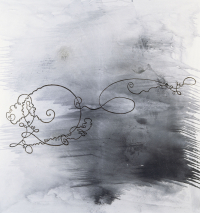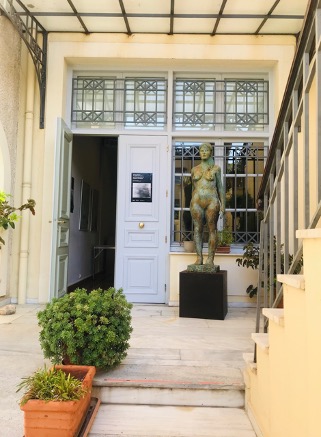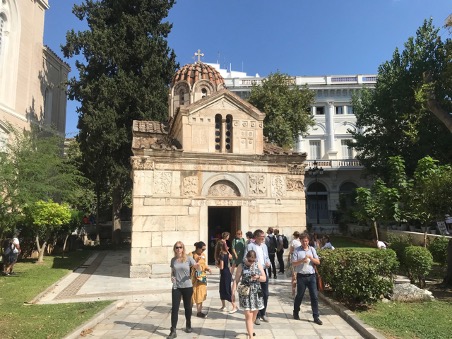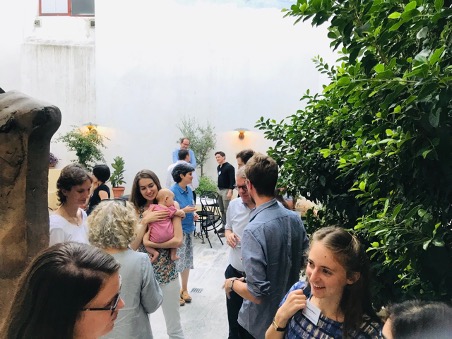
The Transformations and Translocations of Medieval Literature
George Younge writes about the CML summer conference 2019 in Athens
The Centre for Medieval Literature's summer conference in 2019 took place at the Danish Institute, a majestic neoclassical building located in the heart of the Plaka, the bustling old town of Athens. The organising committee considered this an ideal meeting point for a conference which considered the full range of medieval European Literatures (East and West, North and South) within their wider Eurasian and Mediterranean context.

The symposium brought together a diverse group of scholars interested in the movement of people and books across space and time. Speakers were invited to consider the way men and women, clerical and secular, constructed extensive social networks through travel, written communication and the exchange of texts. At the heart of the symposium was a focus on the way literary form responds to cultural movement. We asked speakers to consider how we move from the micro to the macro level, from the close up to the panoramic, without falling into generalizations? What are the advantages of existing methodologies that account for the movement of objects, texts, and people through space? And how does medieval Europe fit into a wider Afro-Eurasian space? Approaching these questions necessarily entailed the act of sifting through difficult and often partial sets of evidence. How do we, as scholars, create narratives out of the trails, traces and clues that remain from the medieval past?
'Though reality may seem to be opaque, there are privileged zones–signs, clues–which allow us to penetrate it'. (Carlo Ginzburg, 'Clues: Roots of an Evidential Paradigm').
Following opening remarks from Professor Elizabeth Tyler, the symposium opened with a keynote from Ingella Nilsson, who offered a thought-provoking discussion of 'Transformation as Spoliation'. Using a range of examples, including the Little Acropolis Church in Athens, Nilsson assessed the conceptual links between architectural spolia and embedded forms.

The first panel of the day examined a range of different examples of 'moving forms' in medieval European literature. Monika Otter discussed the transmission of texts relating to Mary of Egypt, and Marilyn Desmond focused on the dissemination of a specific form, the ottava rima, tracing the use of this form from Boccaccio'sFilostrato to Chaucer's Troilus and Criseyde. In the final paper of the session, Micol Long drew attention to the importance of institutional identity in the remediation of forms, showing how changes in the institutional affiliations of a given author influenced his or her literary output.
The second panel of the day, 'Western Literary Traditions in Central European Manuscripts', included papers by Lucie Doležalová, Klára Petříková, Václav Žůrek, and Pavlína Cermanová. These scholars gave a detailed discussion of the reception and adaptation of new literary forms in late medieval literature from central and east-central Europe. The papers focused on Bohemia and Prague, exploring scribal copying practices (Doležalová), the reception of the Griselda story (Petříková), the role of the universities in facilitating the rise of Latin and vernacular literature (Žůrek), and the vernacular reception of the Secretum secretorum. The panel as a whole drew attention to the vibrancy of central and eastern Europe and helped to give definition to the particular confection of old and new forms in this space.
“it is the relation of networks and wholes that allows us to grasp culture as an object of study” (Caroline Levine, Forms: Whole Rhythm, Hierarchy, Network)
The day concluded with three papers that probed various methodological questions relating to transformation and translocation. Gowaart Van den Bossche's discussion of 'Epistolography, Rhetorics, and Historiography in the Early Mamluk Period' examined a series of letters exchanged by Mongol and Mamluk diplomats. Using the Historia Brittonum as the starting point for her discussion, Máire Ní Mhaonaigh's showed how early Irish writers forged links between their local histories and a more universal past, tracing the descent of the Irish, for instance, from Scythian noblemen, and recording the links between Ireland and Spain. The panel concluded with Jonas Wellendorf's explication of the role of verse and anecdote in early sagas.
The keynote for day two, delivered by Mustafa Bannister, shifted the focus of the symposium to the Egyptian Court and medieval north Africa, describing the movement of texts across the 'medieval Islamic republic of letters' and emphasising the role of travelling scholars in the transmission of literary forms. This initiated a day of broad ranging discussion. A paper from Helen Leslie-Jacobson examined Norwegian law codes through the lens of Derrida's parergon. Doriane Zerka explored the role of 'Women as transcultural agents', taking the case study of Elisabuth of Nassau Saarbrucken as an illustration of the role of female patrons in the dissemination of form and the creation of a common European literary culture. Juan Signes Codoner and Jordan Skinner concluded the afternoon with discussions of the Palestinian Dossier of George the Synkellos and a meditative examination of 'Form as a Mode of Doing'.
After a memorable conference dinner, held on a rooftop terrace on Ermou with a view over the Parthenon, the final day of the symposium commenced with a paper by Elizabeth Tyler on 'connected vernaculars', which theorized the interrelation of different vernacular literary traditions across western and central Europe from Late Antiquity to the Twelfth Century. The first panel of the day, with papers by Peter Chekin, Daria Resh and Lydia Zeldenrust concentrated on the role of French as an international language. Chekin used Actor Network Theory to elucidate the role of nodes and hubs in the dissemination of the Life of St Alexis. Resh and Zeldenrust examined the spread of medieval romance, raising issues relating to the 'popularity' of texts and the perspective of the audience. Drawing on Coldiron's Printers without Borders (2014), Zeldenrust sketched out a range of models for the transmission of romance, including 'serial incidents of translation', 'looping-back translations', 'radiant patterns' and 'compressed patterns. Day three concluded with a roundtable that deconstructed the 'east/west' binaries in scholarship: Stavroula Constantinou examined the reception of Byzantine motifs in Old French literature, Shazia Jagot emphasised the internal role of Islam within Europe, particularly in the pluralistic context of Spain, and Julia Verkholantsev exposed the weaknesses of the category 'eastern European'.
The symposium ended with a ‘Response without conclusions’ by Rosa Rodríguez Porto, a final reflection and wrap-up of previous presentations using the Dürer’s Loop series by Sigmar Polke as a reminder of the crucial role of the visual in thinking about form, translation, and metaphor. And of course with a drinks party in the sun in the courtyard of the Danish Institute.
